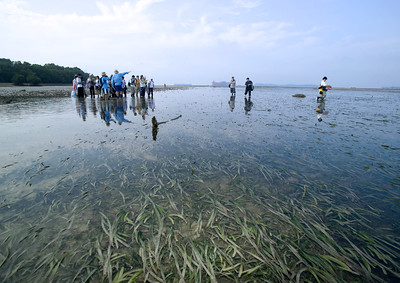We didn't get a chance to survey the shore during mass coral bleaching last year, so it was relief to see the corals seemed alright. Special finds include an elusive anemone, a Giant clam and other interesting marine life. There were lots of lively sharks and sea turtles in the water too. The seagrass situation, unfortunately, remains unchanged.
Today was Special Sea Anemone Day. Kok Sheng spotted an anemone we have not seen before and upon checking with Dr Nicholas Yap, it might be the Radianthus malu - data suggests Singapore lies within its range of distribution, we have searched for and not seen it until today! At the reef edge, Kok Sheng a Merten's anemone - another less commonly seen anemone. As well as large clusters of Magnificent anemones, and some Bubble tip anemones.
 |
| Photos by Loh Kok Sheng |
 |
| Collage of photos by the team. Links to their albums below. |
We did not survey this part of Pulau Semakau during last year's mass coral bleaching event because we ran out of low spring tides - having to cover other shores including those impacted by the Pasir Panjang oil spill. So it was a relief to see that the hard coral situation seems similar to our last survey in Jun 2023 and Jan 2021. Between the reef edge and the lagoon, there are scattered medium to large corals. Mostly boulder shaped. In the shallow pools, there are also some small corals. I didn't see any that were bleaching.
The reef edge remains rich with corals. The team spot many healthy corals including large colonies of Anemone corals. They also spot all the usual mushroom corals including many small Circular mushroom corals. Kok Sheng saw a Sunflower mushroom coral which we rarely see. Some Anchor corals were also seen including the Torch anchor coral which is usually only commonly seen on Semakau.
 |
| Collage of photos by the team. Links to their albums below. |
The other most abundant cnidarians that I saw remained Broad feathery soft corals which formed brown patches sprinkled towards the reef edge. While there also remained many Giant carpet anemones. I saw a Magnificent anemone, and corallimorphs, zoanthids of various kinds.
There used to be a large meadow of long Tape seagrass in a long shallow lagoon here. Here's what it looked like when TeamSeagrass started monitoring the seagrasses here in 2007.
The highlight of the public walk in the past was walking through thick growths of very long Tape seagrass, as in this photo taken in 2008.
Today, the middle of the shallow lagoon remains almost completely bare, with very few clumps of Tape seagrasses, all were cropped. Similar to what we saw on our last survey in Jun 2023 and Jan 2021. But there were still many small colonies of healthy boulder-shaped corals in the lagoon, mostly Pore corals.
There were sprinkles of Spoon seagrass (small leaves) throughout the shore. Kok Sheng saw denser sprinkles between the lagoon and the high shore. There were also tiny scattered patches of Sickle seagrass, Needle seagrass and Serrated ribbon seagrass. All heavily covered in epiphytes.
Most Tape seagrasses I saw remain cropped short and found in just with a pair of leaves. Although I did see a few with long leaves (30cm) in the lagoon area. At the reef edge, I saw more Tape seagrasses in clumps of several and longer leaves (about 30cm).
More about Pulau Semakau
It is NOT true that the construction of the Landfill created the marine life found on Pulau Semakau. The marine life was there long before the Landfill was built.
Just as Changi Airport and Changi Beach are not the same even though they are near one another and share a name, Pulau Semakau is NOT the same as the Semakau Landfill. The Landfill was created by destroying all of Pulau Saking, and about half of the original Pulau Semakau by building a very long seawall. Fortunately, the landfill was constructed and is managed in such a way that the original mangroves, seagrass meadows and reefs on Pulau Semakau were allowed to remain.
What is the fate of Pulau Semakau (West)?
These shores are slated for massive reclamation outlined recently in the Long-Term Plan Review.
The Singapore Blue Plan 2018
Pulau Semakau and nearby islands and submerged reefs have been recommended by the Singapore Blue Plan 2018 for Immediate Conservation Priority. The Blue Plan recommends the intertidal and subtidal marine areas of Pulau Semakau and adjacent Pulau Hantu, and Pulau Jong to be designated Marine Reserve.
The Blue Plan highlights that Pulau Semakau and its associated patch reefs comprise many ecosystems: coral reefs, mangrove areas, intertidal sandflats, seagrass meadows, and coral reefs. The subtidal area of Pulau Jong is larger than the terrestrial area. Pulau Hantu is a popular dive site has seen increasing interest in the past decade due to biodiversity awareness. If protection is accorded to these three islands, zonation plans for use can be implemented to manage tourism and human impacts.
DOWNLOAD the Plan, SUPPORT the Plan! More on the Singapore Blue Plan 2018 site.
Posts by others on this survey
Kelvin Yong
Che Cheng Neo
Richard Kuah
Tammy Lim
Loh Kok Sheng
Tommy Tan
Mathias Luk
Jayden Kang
CQ
Others on this survey: Muhd Nasry












